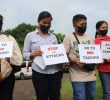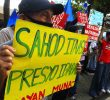By Ervince Apatan
“Wow Davao! Mura na jud og Singapore ba!” (Davao seems to look like Singapore!)
Davao City has been envisioned by its people as a modern city with its recent infrastructure such as the coastal road, underground cabling, and now the bus system that will replace the old jeepneys, thus making Davawenyos believe this city is a globally competitive place imitating the great Singapore.
However, have we considered whether this development is within our financial capacities? Take this modernized bus system for instance.
On its facade, the bus system could provide comfort to every commuter: a fully air-conditioned public transport equipped with comfortable seats, Wi-Fi, and security cameras. But on the flip side, IBON Foundation has estimated the possible fare for modernized public utility vehicles (PUVs) to go up to 300%-400%. This means that the current 13 pesos minimum fare would increase to 30-40 pesos if implemented. A fare hike this great is expected as these more expensive public vehicles would mean more expensive maintenance. Davao is also one of the cities with cheap labor, with only a minimum wage of 438-443 pesos per day. A fare hike is a massive financial burden to everyone.
For jeepney drivers and operators, they are enticed by the government to form cooperatives to be able to shell out 2 million pesos for a single unit of this modern PUV. But the support provided by the administration is not enough. The subsidy for this modernization was only initially set at 80,000 pesos and was increased to 200,000-300,000 pesos. Even with the increase in subsidy, this is not enough to cover.
Nothing compares to the traditional jeepney which could drop a commuter off to their desired destination, especially in downtown areas and subdivision entrances. But the bus system in the city can’t do so as it allocates bus stops only for every 400 meters. Commuters still have to walk a hundred or so meters to reach the bus stop or to their destination, making it less accessible to everyone. The administration acts as if Davao is a walkable city like Barcelona, Tokyo, or Seoul when sidewalks in Davao are as bad as it gets. Most sidewalks in the city are too narrow and crowded, especially within downtown areas and only a few places in the city have convenient sidewalks.
Moreover, there are limitations to the items allowed to carry in the modern bus. Foods from wet markets are not allowed inside, unlike the jeepneys that are being phased out, and the limited routes of pedicabs, imagine commuters coming from the market will have no other accessible transport options except for taxicabs that charge a lot.
This is but an example of class dystopia wherein only the ruling class and rich craft programs and policies, build a society fit for them but are not accessible to the masses who suffer. Where does the administration side on anyway?
The modernization and forced jeepney phaseout is also another way to erase our identity as Filipinos and replace it with the identity of the foreign countries we try hard to imitate. Jeepneys have been ingrained in every Filipino’s cultural identity. The Philippines is unique due to its long history of using jeepneys as public transport and even foreigners who come to the country are in awe of the public transport. Instead of one overruling the other, modernization should blend with tradition.
Many people refer to Davao as “the next Singapore” but people should just start calling Davao as is. Davao is Davao, not Singapore. The city, and the country, can have development without imitating foreign countries. Modernization is not bad and it could be good in order to improve everyone’s quality of life. However, this should be done conforming to the financial capabilities of everyone, not to only a few, which is not being considered. Given the current economic condition of the third-world country and its people, modernization is not easily feasible.
Ervince Apatan is a contributor of Davao Today, currently studying BS Anthropology at the University of the Philippines Mindanao.
bus system, davao city, jeepney, modernization









